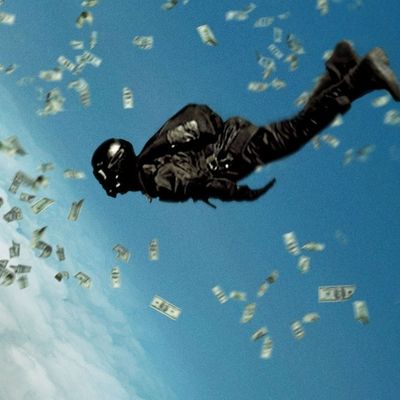
There are about a million reasons why remaking Kathryn Bigelow’s 1991 FBI-agent-goes-undercover-as-a-surfer classic is a bad idea, but let’s focus on the most obvious one. If the original Point Break itself is any good, it’s thanks to Bigelow’s vigorous direction and the breathless, almost romantic chemistry between Keanu Reeves’s hotheaded young FBI agent Johnny Utah and Patrick Swayze’s Zen bank-robber/beach bum/surf-god Bodhi. The film is a stupid idea made sublime. Take Bigelow/Keanu/Swayze out of the equation, and you’re just left with the stupid idea. That said, variations on Point Break do litter the cinematic landscape. And occasionally, they work. That, after all, is how the Fast and the Furious series started, with Paul Walker as the aspiring agent taken in by Vin Diesel’s muscle-car outlaw tribe.
Enter Point Break 2015. The new film’s director, Ericson Core, was the cinematographer on the first Fast & Furious film, so he presumably knows he’s not exactly rediscovering a long-dormant goldmine here. And, having presumably seen the original Point Break, he surely understands that capturing the same lightning-in-a-bottle as that film is unlikely. No, this movie isn’t about characters we love, or high concepts, so much as it’s about #branding. There have been lots of Point Break knockoffs, but there hasn’t been something actually called Point Break. So, here we are.
This time, Luke Bracey’s FBI trainee Johnny Utah is a former motocross champ haunted by the death of his best friend in a riding accident years earlier. And the outlaws he’s infiltrating aren’t beach bums robbing banks to finance their anarchic lifestyle, but a group of hyperserious extreme sportsmen and ecowarriors determined to reach spiritual enlightenment by completing something called the Eight Ordeals, a series of gnomically named mystical-athletic tasks (“Birth of Sky,” “Awakening Earth,” “Master of Six Lives,” etc.) set forth by a long-deceased enviro-guru named Ozaki. The FBI is interested in these guys because, along with their more metaphysical concerns, these daredevils like to “give back,” which, in their case, means robbing diamond-sorting operations and distributing the loot in the slums of Mumbai, or stealing and unleashing giant blocks of U.S. currency over poor Mexican villages. (“This is what chaos looks like!” yells Johnny’s FBI boss, played by Delroy Lindo, in one of the film’s many, presumably intentional, attempts at camp dialogue.)
Uninterested in competing on the bromance front, or even on the action-thriller front, this new Point Break often plays like an extreme-sports documentary with bits of narrative interstitials to carry us along. The production brought together stuntmen and athletes from all around the world for the film’s many setpieces, which include BASE jumping, big wave–riding, motocross, snowboarding, and free-climbing. If you really like that sort of thing, you should see this on the biggest screen you can.
But the results, while impressive, lack both visceral impact and kinetic grace. You admire the skill and bravery that obviously went into the effort, without ever really feeling your pulse quicken, or your breath catch. Core uses a variety of filming techniques — GoPros, helicopter shots, close-ups, etc. — which work well in trying to depict the athleticism involved, but take us out of the action narratively and also — here’s the key — undo our sense of awe. For a film that often asks us to marvel at what’s all around us, that’s borderline fatal. “Isn’t that beautiful, bro?” one character asks repeatedly in the film’s climactic scene, but Point Break’s beauty is strictly of the pretty postcard variety. Its vistas and action scenes barely make an impact; there’s slickness, but no spectacle.
The cast and script aren’t really up to the task, either. If Patrick Swayze’s ridiculous surfer-dude spiritual reveries in the original Point Break somehow worked as part of a self-aware whole, here Ramirez’s ecowarrior pronouncements are played earnestly; there’s a bit of Tyler Durden mixed with this Bodhi, but with little of the requisite narrative savvy or wit. We spend a lot of time of the film hearing about Ozaki’s Eight Ordeals, and the nexus between spiritual enlightenment and environmental justice, but we’re not drawn to any of it. It’s preachy when it should be exciting. Despite all of Ramirez’s best intentions, Bodhi feels less like a dangerous, charismatic outlaw and more like the world’s worst college-seminar leader.
As for Bracey, he’ll make you miss not just Keanu Reeves, but also the late Paul Walker. Both actors at those early stages of their careers were slammed for not having much range. But they had dynamism and physicality, and something even more important: a kind of openness, maybe even a blankness, that allowed us to invest them with meaning. They weren’t deep, but they were effective audience surrogates. Bracey, on the other hand, has a pretty face, but it conveys no inner life. And what good is Point Break if you can’t lose yourself in its wonder, its characters, its awesome, liberating silliness?


